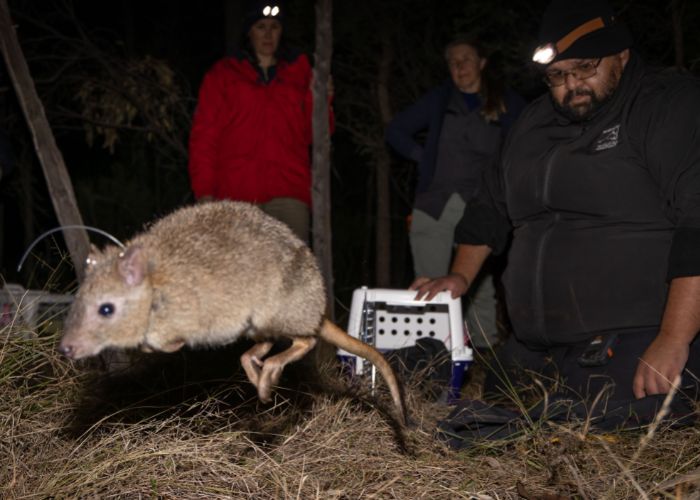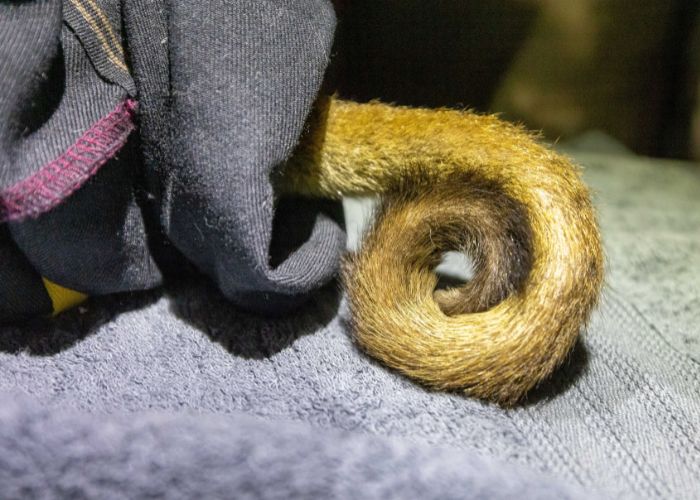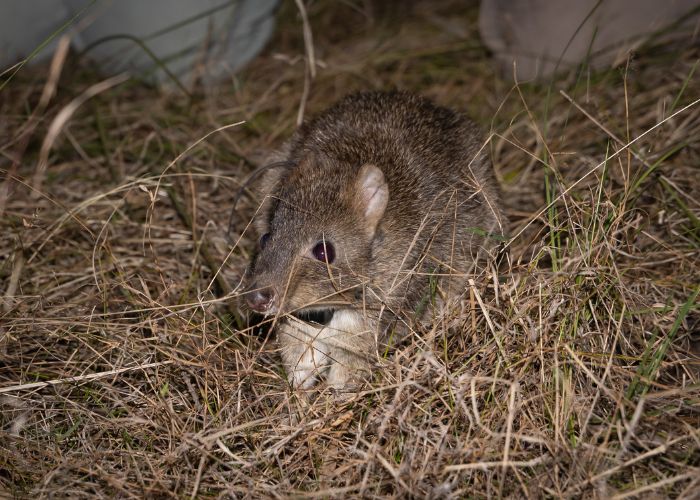The small, kangaroo-like Brush-tailed Bettong has made a historic return to north-western NSW. Fifty-five individuals were reintroduced to the Pilliga State Conservation Area in September 2022, almost 100 years after the species disappeared from the region.
The truffle-eating bettongs travelled directly via a chartered flight from Western Australia to the Pilliga near Narrabri in the North West Plains, NSW. The animals were sourced from Australian Wildlife Conservancy’s (AWC) Mt Gibson Wildlife Sanctuary in the WA Wheatbelt, and Perup Sanctuary (managed by the WA Government) in south-west WA. The reintroduction was carried out by AWC with the NSW National Parks and Wildlife Service (NPWS) as part of a mammal reintroduction program which will ultimately return six locally-extinct species to the Pilliga forest.
Upon arrival to the Pilliga, on Gamilaraay Country, the bettongs underwent a series of health checks. Twenty-six individuals were fitted with tracking collars which were used to monitor their transition to the new environment. They were then released into a 680-hectare feral predator-free area where they joined the Greater Bilby and Bridled Nailtail Wallaby which were reintroduced in 2018 and 2019, respectively. All three species will eventually be released into a larger 5,800-hectare fenced area once the last remaining feral predator, an elusive fox, is removed.
Dr Vicki Stokes, AWC Senior Wildlife Ecologist, welcomed the bettongs back to the Pilliga, saying that they have successfully adapted to their new home.
“It is thrilling to see the Brush-tailed Bettong bouncing around the Pilliga after such a long absence,” said Dr Stokes. “We have been busy tracking them and they are doing very well, with images on our cameras of females with heavy pouches – carrying large pouch young. Two severe weather events in the Pilliga in October and November resulted in extensive flooding. Thankfully the predator-proof fence remained secure. Survival of the reintroduced Bettongs remains high despite the floods, and we expect the new population to thrive with ongoing favourable conditions.”
 Brad Leue/AWC
Brad Leue/AWC
Dr Stokes continued, explaining that threatened species reintroductions are more important than ever, particularly after the sobering findings of the Federal Government’s State of the Environment Report which revealed that the number of listed threatened species has increased by 8% since 2016.
“Their return makes an important contribution to the conservation of the species by establishing an additional secure population. For species like this every population counts,” she said. “They are also hard at work contributing to the restoration of ecological processes in the Pilliga, such as seed and fungal spore dispersal and soil health by digging and moving soil. This is a place where there are supposed to be bettongs as part of the landscape.”
Head of NSW National Parks and Wildlife Atticus Fleming said Brush-tailed Bettongs had now been released in both the Mallee Cliffs and Pilliga feral predator free areas.
 Brad Leue/AWC
Brad Leue/AWC
“This is an historic step in turning back the tide of extinctions in NSW – great news for bettongs and for the Pilliga forest,” he said. “The Brush-tailed Bettong joins the bilby, the Shark Bay bandicoot and the numbat among the ten mammals returned to NSW National Parks in the last four years.”
AWC will monitor the health and size of the reintroduced Brush-tailed Bettong population twice annually over the next few years which will involve radio tracking, live trapping and camera surveys.
The agreement between AWC and the NSW Government, will see at least six mammal species listed as extinct in NSW reintroduced to the feral predator-free area in the Pilliga. These include Greater Bilby (reintroduced in November 2018), Bridled Nailtail Wallaby (September 2019), Brush-tailed Bettong, Plains Mouse, Shark Bay Bandicoot and Western Quoll.
 Brad Leue/AWC
Brad Leue/AWC
Prior to European colonisation, the Brush-tailed Bettong occurred across most of arid, semi-arid and temperate parts of Australia west of the Great Dividing Range, and south of the tropics. Remnant populations of the species are restricted to south-west WA, however those populations have experienced a decline of 90% in the last 20 years.
The Brush-tailed Bettong disappeared from NSW by the early 20th century. A bounty system operating in NSW between 1880-1920 saw millions of ‘rat kangaroos’ killed. Populations were also decimated by the introduction of feral cats and foxes, which remain a major threat to the species’ persistence.
The life expectancy of the bettong is approximately 4-6 years and females can begin breeding from five months of age. During the day, they rest in well-concealed nests made of long strands of grass and bark, and they emerge at night in search of food, with a particular preference for subterranean fungi (truffles), as well as herbage, fruits/seeds and invertebrates.
The Brush-tailed Bettong is the most widely translocated Australian mammal, with over 60 translocations to sites in WA, SA and NSW. AWC has successfully established reintroduced populations in feral predator-free fenced areas at Yookamurra (SA), Karakamia (WA) and Mt Gibson (WA) Wildlife Sanctuaries. In 2021, AWC also successfully reintroduced Brush-tailed Bettongs to Mallee Cliffs National Park (NSW) as part of its ongoing partnership with NPWS the NSW Government.
Support Australian Wildlife Conservancy's science-led conservation work and safeguard the future of Australia's native species
Donate Now